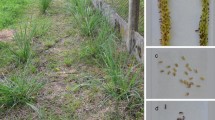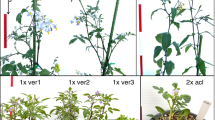Abstract
The number of chromosomes in cells of the root meristem of seedlings of wild and cultivated species of Cruciferae plants capable of hybridizing with rapeseed Brassica napus is studied. Only diploid metaphases are observed in seedlings of Brassica juncea, Diplotaxis tenuifolia, and Raphanus raphanistrum. In B. napus and B. cretica roughly 5% of the seedlings are mixoploid. Diploid cells are dominant in the mixoploids, though hypo-and hyperdiploids are also encountered. Nearly 20% of the seedlings of B. campestris and R. sativum are mixoploid, a significant fraction of which contains di-triploid chimeras. In B. nigra less than one-half of the seedlings are truly diploid, the majority of the plants being mixoploid. Seedlings containing preferentially tetraploid and triploid cells are dominant. The biological significance and possible causes of the newly discovered mixoploidy are discussed.
Similar content being viewed by others
References
Kunakh, V.A., Biotekhnologiya likars’kykh roslyn. Genetychni ta fiziologo-biokhimichni osnovy (Biotechnology of Medicinal Plants. Genetic and Physiological and Biochemical Aspects), Kiev: Logos, 2005.
Maletskii, S.I., Epigenetic and Synergidic Forms of Hereditary of Reproductive Traits in Angiospermous Plants, Zhurn. obshch. biologii, 2004, vol. 65, no. 2, pp. 116–135.
Maletskii, S.I., Hierarchy of Units of Hereditary. Variability and Inheritance of Traits in Species Formation in Plants, in Epigenetika rasteniy: Sb. nauch. tr. In-ta tsitologii i genetiki SO RAN (Epigenetics of Plants. Studies from the Institute of Cytology and Genetics, Siberian Division of the Russian Academy of Sciences), Novosibirsk, 2005, pp. 7–53.
Damsz, B. and Luchniak, P., Nuclear DNA Endoreplication and Plastid Index in Mesophyll of some Dicotyledonout Species, Acta Soc. Bot. Pol., 1988, vol. 57, no. 3, pp. 303–316.
Kudo, N. and Kimura, Y., Flow Cytometric Analysis for System in Development of Radish (Raphanus sativum L.), Plant Biotechnol., 2002, vol. 19, no. 1, pp. 45–52.
Li, Z., Liu, J., and Heneen, W.K., Production and Cytogenetics of the Intergeneric Hybrids Brassica juncea (Orychophragmus violaceus and B. carinate (B. violaceus), Theor. and Appl. Genet., 1998, vol. 96, no. 2, pp. 251–265.
Li, Zai-yun and Ge Xian-hong, Unique Chromosome Behavior and Genetic Control in Brassica (Orychophragmus Wide Hybrids: A Review), Plant Cell Rep., 2007, vol. 26, no. 6, pp. 701–710.
Ovcharenko, O.O., Rudas, V.A., and Kuchuk, M.V., Somatic Hybridization in Brassicaceae Plants, Visn. Kharkiv. nats. agrar. un-ta. Ser. Biol., 2006, issue 1 (8), pp. 7–20.
Yevtushenko, Yu.V., Kunakh, V.A., and Blyum, Ya.B., Evaluating the Risk of Vertical Transfer of Genes in Cultivation of Genetically Modified Rapeseed Cultivars in Ukraine, Biotekhnologiya v rastenievodstve, zhivotnovodstve i veterinarii: Materialy II Mezhdunarod. nauch. konf. (Biotechnology in Plant Growing, Animal Husbandry, and Veterinary Science: Proc. Second International Scientific Conference), Moscow, October 18–19, 2000; Moscow, 2000, pp. 144–145.
Novozhilov, O.V. and Blyum, Ya.B., Criteria for Estimating the Ecological Risk of Vertical Transfer of Genes in the Use of Transgenic Plants, in Genetika i selektsia v Ukraine na mezhi tisyacholits’ (Genetics and Selection in the Ukraine at the Turn of the Century), Morgun, V.V., Ed., Kiev: Kolos, 2001, vol. 1, pp. 501–519.
Radchuk, V.V. and Blyum, Ya.B., Advances and Problems in Genetic Transformation of Plants in the Cruciferae Family, Tsitol. Genet. (Riga), 2005, vol. 39, no. 3, pp. 13–29.
Kunakh, V.A., Genomic Variability of Somatic Plant Cells. 2. Variability in Nature, Biopolimery i kletka, 1995, vol. 11, no. 6, pp. 5–40.
Snowdon, R.J., Cytogenetics and Genome Analysis in Brassica Crops, Chromosome Res., 2007, vol. 15, pp. 85–95.
Sheid, O.M., Jakovleva, L., Afsar, K., Maluszynska, J., and Paszkowski, J., A Change in Ploidy Can Modify Epigenetic Silencing, Proc. Nat. Acad. Sci. USA, 1996, vol. 93, pp. 7114–7119.
Author information
Authors and Affiliations
Corresponding author
Additional information
Original Ukrainian Text © V.A. Kunakh. V.I. Adonin, S.P. Ozheredov, Ya.B. Blyum, 2008, published in Ukrainian in Tsitologiya i Genetika, 2008, Vol. 42, No. 3, pp. 83–88.
About this article
Cite this article
Kunakh, V.A., Adonin, V.I., Ozheredov, S.P. et al. Mixoploidy in wild and cultivated species of Cruciferae capable of hybridizing with rapeseed Brassica napus . Cytol. Genet. 42, 204–209 (2008). https://doi.org/10.3103/S0095452708030079
Received:
Published:
Issue Date:
DOI: https://doi.org/10.3103/S0095452708030079




